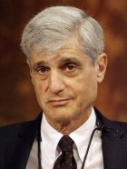For most people, debating economic doctrines is a pastime best left to the Ph.D. economists working in government, think tanks and universities. Yet economic doctrines are at the heart of the economic policies being debated right now in the presidential campaign, in the halls of Congress, and in the current administration. Virtually all policy makers involved in economic policy, including our two major Presidential candidates, subscribe to a particular economic doctrine, even if they may not be aware of which "camp" they are in.
(To find out which camp you are in, take the online test at www.innovationeconomics.org).
Their doctrine guides their thinking and deliberations, helps them make sense of an incredibly complex and rapidly changing economy, and aids them in deciding the "correct" economic policy to pursue. Indeed, as John Maynard Keynes once stated, "Practical men, who believe themselves to be quite exempt from any intellectual influences, are usually the slaves of some defunct economist."
Today, there are three incumbent economic doctrines, and a fourth being the new kid on the block - all competing for the attention and allegiance of Washington policy makers.
Supply Side Economics
 Arthur Laffer, supply-side economist who popularized the Laffer curve, which postulated that as tax rates grew beyond a certain point, tax revenues fell.
Arthur Laffer, supply-side economist who popularized the Laffer curve, which postulated that as tax rates grew beyond a certain point, tax revenues fell.
Conservatives are generally unified in their economic thinking, in large part because most subscribe to Supply Side Economics, a doctrine that emerged during the Reagan administration. Supply-side economics holds that capital accumulation drives growth, and that the most important role for government is to remove disincentives to capital formation, especially by reducing taxes on capital and earnings, especially on the highest marginal tax rates. It holds that markets generally get it right, and that government intervention should be limited, including through a simple tax code with low rates and few deductions. But markets only get it right if they get the right price signals, so supply-side economics focuses on making sure that there are as few distortions to the market as possible. Finally, the overriding goal of supply-side economics growth; equity issues are best left to the market. Supply-siders find their institutional DC home in places like the American Enterprise Institute, Heritage Foundation, the Cato Institute, the Competitive Enterprise Institute, and a host of other conservative think tanks.
Liberal Neo-Classical Economics (Rubinomics)
 Robert Rubin, former Clinton Administration Treasury Secretary and father of "Rubinomics."
Robert Rubin, former Clinton Administration Treasury Secretary and father of "Rubinomics."
For policy makers who like markets and believe that capital is the key to growth, but are more sympathetic to government and more concerned about fairness, Liberal Neo-Classical Economics (Rubinomics) is for them. Rubinomics holds that capital accumulation drives growth, and that the most important role for government is to spur more savings and investment by reducing the budget deficit and encouraging low and moderate income individuals to save more. It holds that markets generally get it right, but that government intervention is warranted to bring about fairer economic outcomes. But markets only get it right if they get the right price signals, so Rubinomics focuses on making sure that there are as few distortions to price signals as possible, including by favoring a simpler tax code with fewer deductions, and more progressivity. Liberal neo-classicalists find their DC homes at places like the Brookings Institution, the Peterson Institute, the Center for American Progress, and a host of other politically moderate think tanks employing economists.
Neo-Keynesian Economics John Maynard Keynes, British economist and author of The General Theory of Employment.
John Maynard Keynes, British economist and author of The General Theory of Employment.
Much of the left still subscribes to Keynesian Economics, 70 years after Keynes set forth the doctrine. Neo-Keynesians hold that it is the demand side of the economy that is most responsible for spurring growth, and that the most important role for government is to spur demand by expanding spending and public investment. It holds that markets often get it wrong, especially in terms of producing equitable outcomes, so active government intervention is warranted. Because markets are prone to underperforming, neo-Keynesians believe government should play an active role in ensuring that the economy runs at full employment, which they see as a key to helping workers benefit from economic growth. Finally, they see equitable distribution of economic output as a key goal, not just to promote fairness, but to promote consumer demand and faster economic growth. Most neo-Keynesians are on the left side of the political spectrum, with DC institutional homes in places like the Economic Policy Institute, the Center for Economic and Policy Research, the AFL-CIO, the Center on Budget and Policy Priorities, and the Center for American Progress (also home to some liberal neo-classicalists).
Each of these three prevailing doctrines provide important insights into the economy and in many ways are important guides to policy makers. And all three are playing key roles in shaping the economic proposals of the two candidates. Senator McCain's proposals to keep individual marginal tax rates low comes straight from the supply-side playbook. Senator Obama's focus on providing middle-class tax relief, increased minimum wage, and greater worker rights to organize owes its origins to Keynesian thinking about spurring consumer demand. And both campaigns' nod to fiscal discipline reflects Rubinomics' belief in the importance and power of lower interest rates.
But unfortunately, neither Keynesian economics, supply-side economics, nor Rubinomics alone offer the kind of economic policy framework that fits the new economic realities of the twenty-first century. All focus in an almost Newtonian way on adjusting the demand or supply of capital and labor to keep the economy in equilibrium. All focus on macroeconomic factors, particularly prices rather than on the institutional factors and technological change, that really drive growth. And none have much to say about the complex process by which technological innovation occurs. Luckily within the last decade a theory and narrative of economic growth focused on innovation has emerged.
 Joseph Schumpeter, Austrian economist, author of 1942 book Capitalism, Socialism and Democracy coined the term "creative destruction" and is seen as the father of "innovation economics."
Joseph Schumpeter, Austrian economist, author of 1942 book Capitalism, Socialism and Democracy coined the term "creative destruction" and is seen as the father of "innovation economics."
Innovation Economics holds that it is innovation that drives growth and that the most important economic task for government is to promote productivity growth and innovation, even if such policies "distort" the market. While markets get it right sometimes, when it comes to spurring innovation and productivity, innovation economics holds that markets and price signals alone often are not enough. Therefore, innovation economics holds that policies to help institutions (e.g., entrepreneurs, firms, industries, universities, regions, and governments) act in ways that increase innovation and productivity should be at the center of economic policy. Among other tools, this entails an array of public-private partnerships and public investments in the building blocks of innovation.
It is in this context that the emergence of a new economic doctrine - innovation economics - is so important. For while the coach may call the plays, the playbook lays out his or her choices. And the current playbooks in Washington now severely limit the plays that the coach (economic policy makers) can call.
But fortunately we already see aspects of the influence of innovation economics in both campaigns. The McCain campaign released its tech plan last week and, while light on details, it does recognize the importance of innovation and has several proposals inspired by innovation economics, including allowing companies to expense in the first year investments in new equipment and an expansion of the R&D tax credit. The Obama campaign very detailed tech plan was released months ago and it too has a number of innovation economics inspired proposals, including driving change in sectors like health care and government through greater use of information technology and significant expansion of federal support for R&D.
While innovation economics is still the new kid on the block, it's beginning to get some respect, as policy makers are beginning to understand that in a 21st century knowledge and innovation-based economy, 20th century economic doctrines don't cut it.
To "Learn Your Economic Type" go to www.innovationeconomics.org and take the test.
